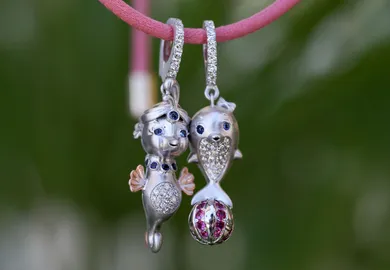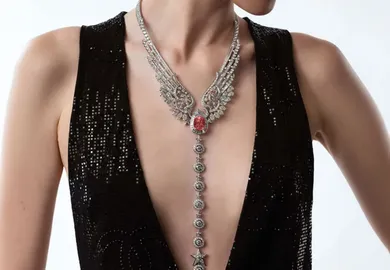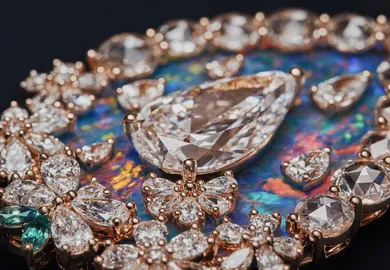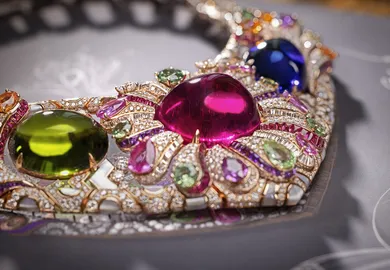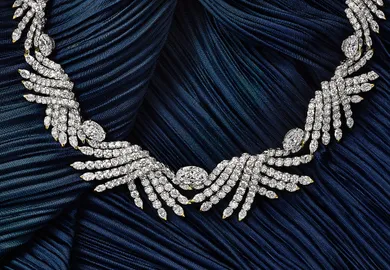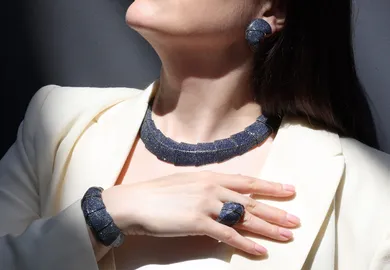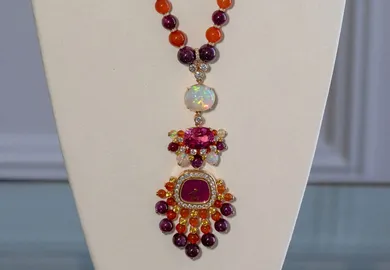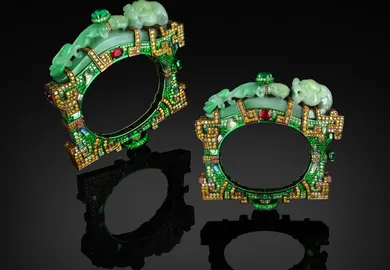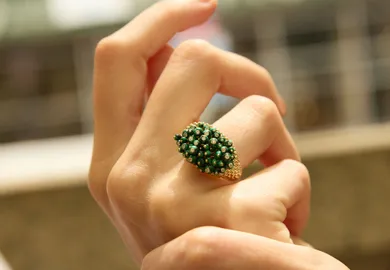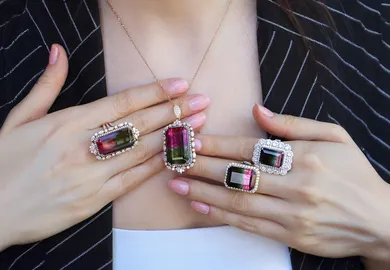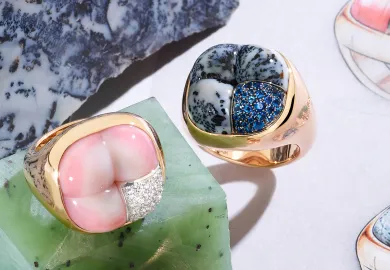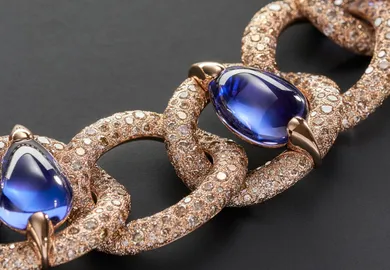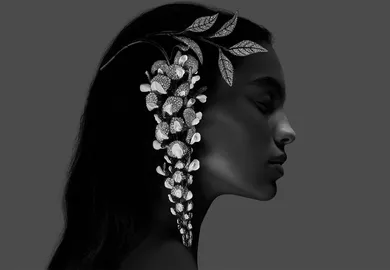

Haute Couture 2025: The 70s Depths of the Piaget Shapes of Extraleganza High Jewellery Collection
In the golden haze of the 1970s, boundaries were there to be broken. Art collided with fashion on the dancefloors of Paris and New York. Design became sculptural, jewellery turned subversive, and self-expression was the only rule worth following. In the middle of it all was Yves Piaget, a fixture on the scene and a friend to the cultural vanguard, from Salvador Dalí to Andy Warhol. Through the Piaget Society, a circle of artists, collectors and freethinkers, the Maison helped shape the cultural zeitgeist of the 1970s.
That fearless spirit has been reborn in Shapes of Extraleganza, the second in a trilogy of High Jewellery collections from Piaget that revisit the Maison's radical 1960s and 70s design codes. While last year's Essence of Extraleganza celebrated the sensuality of Piaget's signature textures and stones, Shapes dives deeper into geometry, volume and artistic expression.

In Shapes of Extraleganza, Piaget revisits the Maison's radical 1960s and 70s design codes, including the iconic "Swinging Sautoir" - a new way to read time
Fittingly, the collection was unveiled in Barcelona, a city brimming with creative energy, coastal glamour and architectural daring. The setting was Casa de Xavier Corberó, a sprawling surrealist complex created by the Catalan sculptor and architect as a living, breathing artwork. With its interlocking arches, sculptural voids and labyrinthine courtyards, Corberó's concrete sanctuary was the perfect stage for Piaget's latest explorations of form, colour and material.
A decade of cultural liberation and visual excess, the 1970s marked a turning point when Pop Art, Op Art and psychedelic design shattered conventions and transformed how the world dressed, lived and expressed itself. In this heady creative climate, Yves Piaget launched the Piaget Society: a collective of artists, muses and tastemakers united by a shared hunger for experimentation. Shapes of Extraleganza, like Essence before it, channels the society's liberated energy, recasting high jewellery as a space for bold ideas and joyful defiance.
Within the collection, circles collide with zigzags, triangles nestle within waves of diamonds, and shapes jostle and layer in rhythmic, sculptural compositions that feel more like wearable architecture than traditional high jewellery. These bold forms echo the visual language of the 1970s, from the curvaceous experimentation of Italian avant-garde design to the punchy, postmodern playfulness of the Memphis Group.
By pairing high jewellery materials with unconventional design cues, Piaget plays with the tension between elegance and irreverence, transforming gold, gemstones and ornamental stones into shape-shifting works of art. Nowhere is this more apparent than in the Kaleidoscope Lights suite: a vibrant, Op Art-inspired collar, ring and earrings striped with patterned slices of ornamental stone—a joyful collision of jasper, turquoise, chrysoprase and rhodochrosite, alongside lesser-known sodalite, sugilite, ruby roots and rhodonite. Piaget's artistic director spent a day at the stone store—the same one used since the 1960s—arranging the stones like a puzzle to find the perfect colour balance. Inspired by the hardstone dials Piaget pioneered in the 1960s, the necklace alone required over 300 hours of craftsmanship.
The contrast between hardstones is pushed to the extreme in the Kaleidoscope Lights high jewellery timepiece. Radiating from the centre like a psychedelic sunburst, the marquetry dial features slices of richly patterned hardstones, outlined with a halo of multi-coloured baguette cut gems, with an ultra-thin Altiplano flying tourbillon movement beating beneath its graphic surface. It's a watch that captures the full spectrum of Piaget's artistry across both watchmaking and jewellery making.
Piaget's legacy of transformable design is revisited in a new Watch Swinging Sautoir. A signature silhouette first introduced in 1969, it has been reimagined in a bold, high-colour palette of ruby root, garnets, white opal and spinel. The handmade chain is intentionally left visible—a deliberate contrast to the traditional high jewellery impulse to encrust every surface with gems. True to Piaget's love of ingenuity, the watch element can be detached with a one-click mechanism and worn on a strap, transforming the necklace into a standalone timepiece.
At Piaget, watchmaking and jewellery are two art forms in constant conversation, with a series of high jewellery timepieces a highlight of the new Shapes of Extraleganza collection
In Yves Piaget's eyes, opals are living canvases, far beyond the realm of typical gemstones. Captivated by their elusive inner light, they are his favourite stone, and he champions them for their ability to shift colour and emotion with each flicker of light. His fascination is vividly expressed in the Flowing Curves suite, where rare black Australian opals take centre stage. Framed by cascades of diamonds that echo the motion of water, the opals appear to ripple with their own internal tide. A tribute to the 1970s "back to nature" movement that rejected consumerism in favour of environmentalism, the suite embraces the era's affinity for sensual, organic forms.
Flowing Curves is also a showcase of technical mastery, marking the debut of a groundbreaking goldsmithing technique. Crafted in heavily textured, hand-hammered white gold, the free-flowing opals appear to drift across the surface of the necklace, ring and earrings, defying the rigid conventions of high jewellery.
The Curved Artistry suite shifts the tempo, offering a moment of graphic clarity. Channelling the offbeat language of the Memphis Group, whose designers transformed the ordinary into the extraordinary, the interlocking forms of chrysoprase and troilite recall the structural precision of modular design. Yet each stone is domed, each angle gently curved, lending the pieces a soft beauty that tempers their geometry. Where the Memphis Group favoured bold primary colours, Piaget opts for cool green chrysoprase and milky blue troilite, punctuated by the brilliance of a 10.91 carat octagonal cut yellow sapphire from Sri Lanka. The transparency of the stones allows them to light up against the skin, making them pop.
High jewellery meets high energy in the Wave Illusion suite, which reveals Piaget at its most exuberant. Inspired by a 1970s Ettore Sottsass mirror, rare spinels in saturated shades of red and pink collide with rubies and diamonds. The necklace curves outwards in a sculptural arc that hugs the neckline with its dynamic form, highlighting Piaget's talent for transforming gold into movement. Nearly 500 hours in the making, the free-spirited design dances with the same bold optimism that defined Piaget in the 1960s and 70s. The whole set has already been sold, and the client purchased both pairs of earrings because she couldn't decide between them.
At first, Arty Pop presents as relatively restrained, with the drop earrings almost classical in their elegance. But the suite's hoop earrings go full 1970s, with jagged triangular malachite inlays that mirror their spiky silhouettes. Like the graphic "pow!" in a Roy Lichtenstein painting, rendered in precious stones, they inject an unexpected jolt of Pop Art cool into this high jewellery set.
The spirit of Arty Pop reaches its peak in the timepiece, a vivid reminder that, at Piaget, watchmaking and jewellery don't exist in isolation. Housing an ultra-thin Altiplano flying tourbillon movement, an explosive three-dimensional burst of emeralds, chrysoprase and malachite at 8 o'clock, it's part watch, part artwork, all attitude.
The revolutionary heart of Shapes of Extraleganza is, without a doubt, Endless Motion: a one-of-a-kind table clock designed in collaboration with French artist and mobile-maker Alex Palenski, whose kinetic work pays homage to Alexander Calder. Marking a return to creating objects, as Piaget did in the 1970s with luxury items such as lighters and glasses, Suspended on delicate golden branches, turquoise slices orbit around a black opal dial in a beautifully choreographed dance of movement and balance. A meditation on motion and Piaget's refusal to stand still, Endless Motion is the latest in a long line of creative exchanges between the Maison and the art world.

Designed in collaboration with French artist and mobile-maker Alex Palenski, the Endless Motion table clock marks a return to Piaget creating objects, as it did in the 1970s
With Shapes of Extraleganza, Piaget reclaims its avant-garde past and reframes it for the now. Just as Yves Piaget once gathered artists, icons and visionaries on the sun-soaked shores of the Mediterranean, this collection invites a new generation into the spirit of the Piaget Society, where creativity moves freely, shapes speak boldly, and the line between jewellery and art disappears.

WORDS
Claire Roberts has been writing about jewellery and watches for more than 20 years. She is a seasoned journalist who joined the team 5 years ago as a contributing writer and a newsletter editor.
Related Articles
Latest Stories
Add articles and images to your favourites. Just

Epic Evolution:Miseno Launches the Arco Collection to Celebrate a Fabulous Decade
I am pleased to present to you my highlights of the new Arco High Jewellery collection, which was formally showcased to the jewellery world at Couture from June 4-8, 2025
Jewels Katerina Perez Loves
Continue Reading

In Conversation:Discussing Paraiba - The Legacy of a Color
with Vogue Singapore
Brand Focus: Pomellato
Jewellery Insights straight to your inbox




















